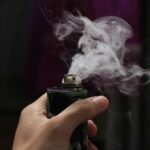Healing Breath: Can Lungs Recover from Vaping?

In a world where the allure of vaping has captivated millions, a pressing question lingers: Can Lungs Recover from Vaping? The lungs can regenerate damaged tissue, however, when damage is too extensive, it may be permanent
Understanding whether the lungs can heal from any damage vaping might cause may depend on the extent and type of damage.
As we navigate the complex landscape of respiratory health, it’s crucial to confront this inquiry head-on and explore the possibilities of redemption for those ensnared by the tendrils of vaping addiction.
Healing breath – a concept imbued with hope and possibility – beckons us to delve into the depths of scientific inquiry and unravel the mysteries of lung regeneration.
But amidst the haze of uncertainty, one thing remains clear: the human body possesses an innate resilience, a capacity to heal and rejuvenate even in the face of adversity.
Yet, the path to lung recovery is fraught with challenges, as the lingering effects of vaping cast a shadow over the journey toward respiratory redemption. From inflammation and oxidative stress to impaired ciliary function, the toll of vaping on pulmonary health is undeniable.
But as we stand at the crossroads of despair and determination, a glimmer of hope emerges – recent research suggests that with the right interventions and support, lungs damaged by vaping may indeed have the potential to heal and thrive once more.
Vaping, once considered a niche hobby, has now permeated mainstream culture, with millions of individuals worldwide embracing electronic cigarettes as a purportedly safer alternative to traditional smoking. The proliferation of vaping products, coupled with aggressive marketing tactics targeting adolescents and young adults, has contributed to its widespread adoption.
Join us on a quest for answers as we unravel the mysteries of lung recovery in the wake of vaping addiction. From cutting-edge medical treatments to holistic healing modalities, we’ll explore the myriad pathways toward respiratory renewal and reclaiming the gift of breath.
Vaping’s Impact on Lung Health
While initially marketed as a smoking cessation aid, the safety of vaping remains a subject of intense debate among healthcare professionals and regulatory agencies. The inhalation of aerosolized substances produced by e-cigarettes exposes the lungs to a myriad of chemicals, raising concerns about potential adverse effects on respiratory function and long-term health outcomes and its Lungs Recover from Vaping.
The Effects of Vaping on Lung
Contrary to popular belief, vaping is not without its risks, particularly concerning its impact on lung function. The inhalation of vaporized chemicals can trigger inflammation and oxidative stress within the respiratory tract, compromising lung function and increasing susceptibility to respiratory ailments.
Chemical Inhalation: Dissecting the Ingredients
E-liquids used in vaping devices contain a complex mixture of chemicals, including nicotine, propylene glycol, and various flavorings. When heated, these substances undergo chemical reactions, producing toxic byproducts such as formaldehyde and acrolein, which can damage lung tissue and impair respiratory effective function.
Immediate Effects: Acute Impact on Respiratory System
Upon inhalation, the vapor produced by e-cigarettes rapidly deposits microscopic particles deep within the lungs, eliciting an immediate inflammatory response. Acute symptoms such as coughing, wheezing, and shortness of breath may ensue, reflecting the lungs’ struggle to cope with the influx of foreign substances.
Long-Term Consequences: Chronic Conditions Linked to Vaping
Beyond the acute effects observed in the aftermath of vaping, there exists growing evidence linking e-cigarette use to the development of chronic respiratory conditions. Chronic obstructive pulmonary disease (COPD), bronchiolitis obliterans (“popcorn lung”), and asthma exacerbations are among the documented consequences of long-term vaping.
The Journey to Recovery
Ceasing Vaping: The First Step Towards Healing
For individuals grappling with vaping-related lung injury, the decision to quit represents the crucial first step toward Lung Recover from Vaping . By eliminating exposure to aerosolized toxins, the lungs are afforded the opportunity to heal and regenerate damaged tissue.
Benefits of Quitting: Rapid Improvement in Lung Function
Research indicates that quitting vaping leads to rapid improvements in lung function, with noticeable reductions in respiratory symptoms within weeks of cessation. Increased lung capacity, improved oxygenation, and enhanced mucociliary clearance are among the early benefits observed in individuals who abstain from vaping.
Clearing the Air: Reducing Inflammation and Irritation
As the body detoxifies from the harmful substances present in e-cigarettes, systemic inflammation decreases, alleviating strain on the lungs and promoting tissue repair. The cessation of vaping also fosters the resolution of respiratory symptoms such as coughing, wheezing, and chest tightness.
Short-Term Recovery: What to Expect in the Early Stages
In the Lungs Recover from Vaping Process, In the initial stages of vaping cessation, individuals may experience a range of respiratory symptoms as the lungs begin to heal. However, these transient discomforts are often overshadowed by the tangible improvements in breathing capacity and overall respiratory comfort.
Improved Breathing: Alleviating Shortness of Breath
One of the most noticeable benefits of quitting vaping is the alleviation of shortness of breath, a common complaint among e-cigarette users. As lung function improves and airway inflammation subsides, individuals report a newfound sense of ease and comfort with each breath.
Restored Sense of Smell and Taste: Rediscovering Senses
In addition to improvements in lung function, quitting vaping often coincides with a restoration of olfactory and gustatory sensations. The reawakening of taste buds and olfactory receptors enhances the sensory experience of food and beverages, further motivating individuals to maintain their vape-free lifestyle.
Medium-Term Recovery: Progressing Towards Healthier Lungs
As weeks turn into months, the benefits of quitting vaping continue to accrue, ushering in a phase of sustained lung recovery and revitalization. During this medium-term recovery period, individuals may notice further improvements in respiratory function and a reduction in lingering symptoms associated with e-cigarette use.
Reduction in Coughing: Restoring Normal Function
Persistent coughing, a hallmark symptom of vaping-related lung injury, tends to diminish with sustained abstinence from vaping. As the lungs’ natural defense mechanisms rebound, the frequency and severity of coughing episodes decline, signaling the restoration of normal respiratory function.
Regeneration of Lung Tissue: Healing Damaged Cells
Underlying the process of lung recovery is the remarkable capacity of the body to repair and regenerate damaged tissue. With vaping cessation, the inflammatory milieu within the lungs subsides, allowing for the proliferation of healthy cells and the restoration of normal lung architecture.
Long-Term Recovery: Sustaining Lung Health over Time
While the short and medium-term benefits of quitting vaping are undeniably encouraging, the ultimate goal of lung recovery lies in achieving sustained and long-lasting improvements in respiratory function. By adopting a holistic approach to lung health and addressing factors that may impede recovery, individuals can optimize their chances of enjoying a vape-free future with healthy lungs.
Lowering the Risk of Chronic Conditions: Mitigating Future Complications
By quitting vaping and reducing exposure to airborne toxins, individuals can significantly lower their risk of developing chronic respiratory conditions such as COPD and lung cancer. Furthermore, by addressing modifiable risk factors such as tobacco use and environmental exposures, individuals can take proactive steps towards safeguarding their lung health for years to come.
Building Lung Resilience: Strengthening Against External Stressors
In addition to mitigating the risk of chronic disease, quitting vaping enhances the body’s resilience to external stressors and promotes overall lung vitality. By embracing a lifestyle characterized by regular exercise, a nutritious diet, and avoidance of respiratory irritants, individuals can fortify their lungs against future insults and optimize their respiratory well-being.
Factors Influencing Recovery
Personal Health Factors: Understanding Individual Variations
The journey to lung recovery is highly individualized, with numerous personal health factors influencing the pace and extent of recovery. Age, gender, genetic predispositions, and pre-existing health conditions all play a role in shaping an individual’s response to vaping cessation and subsequent lung healing.
Age, Gender, and Genetic Predispositions: Impact on Recovery Timeline
Age and gender are key determinants of lung health, with younger individuals and females generally exhibiting greater resilience and faster recovery from vaping-related lung injury. Furthermore, genetic variations in detoxification pathways and lung function genes may confer susceptibility to vaping-related harm, influencing the trajectory of recovery.
Pre-existing Health Conditions: Managing Comorbidities
Individuals with pre-existing health conditions such as asthma, chronic bronchitis, or immunodeficiency disorders may face unique challenges in recovering from vaping-related lung injury. Close collaboration with healthcare providers is essential to manage comorbidities effectively and optimize lung healing in these individuals.
Lifestyle Choices: Optimizing Recovery through Healthy Habits
While certain factors influencing lung recovery may be beyond an individual’s control, lifestyle choices play a crucial role in supporting and accelerating the healing process. Adopting healthy habits such as regular exercise, balanced nutrition, adequate hydration, and avoidance of respiratory irritants can enhance lung recovery and promote overall well-being.
Nutrition and Hydration: Supporting Lung Healing
A nutrient-rich diet abundant in antioxidants, vitamins, and minerals provides the building blocks necessary for tissue repair and immune function, facilitating lung healing and regeneration. Adequate hydration is equally important, as it helps maintain optimal mucociliary clearance and prevents dehydration-induced respiratory symptoms.
Physical Activity: Boosting Lung Function and Vitality
Regular physical activity not only strengthens the cardiovascular system but also enhances lung function and capacity. Aerobic exercises such as walking; jogging, cycling, and swimming promote efficient oxygen utilization, improve respiratory muscle strength, and enhance overall lung vitality.
Environmental Factors: Minimizing Exposure to Lung Irritants
In addition to personal health factors and lifestyle choices, environmental factors exert a significant influence on lung health and recovery. Minimizing exposure to airborne pollutants, allergens, secondhand smoke, and occupational hazards is essential to prevent exacerbation of respiratory symptoms and promote lung healing.
Avoiding Secondhand Smoke: Protecting Recovering Lungs
Secondhand smoke contains a myriad of toxic chemicals and carcinogens that can compromise lung health and impede recovery from vaping-related lung injury. Individuals striving to quit vaping should avoid exposure to secondhand smoke and create smoke-free environments to protect their healing lungs.
Creating a Clean Air Environment: Enhancing Lung Health at Home
Creating a clean air environment is paramount to supporting lung health and facilitating recovery from vaping-related lung injury. Simple measures such as using air purifiers, maintaining adequate ventilation, and avoiding indoor air pollutants can significantly improve indoor air quality and promote respiratory well-being.
Supporting Recovery
Seeking Professional Guidance: The Role of Healthcare Providers
In navigating the journey to lung recovery, individuals are encouraged to seek professional guidance from healthcare providers specializing in respiratory health and smoking cessation. Physicians, pulmonologists, respiratory therapists, and smoking cessation counselors can offer personalized guidance, support, and medical interventions to facilitate vaping cessation and promote lung healing.
Consultation with a Physician: Tailoring Recovery Plans
A consultation with a physician is an essential step for individuals seeking to quit vaping and embark on the path to lung recovery. During this consultation, healthcare providers conduct comprehensive assessments, evaluate lung function, and tailor personalized recovery plans to address individual needs, preferences, and medical considerations.
Utilizing Smoking Cessation Programs: Accessing Resources for Support
Smoking cessation programs offer a wealth of resources, support, and evidence-based interventions to assist individuals in quitting vaping and overcoming nicotine addiction. These programs may include counseling, behavioral therapy, pharmacotherapy, and peer support groups, all of which are instrumental in promoting successful vaping cessation and sustaining long-term abstinence.
Building a Support Network: Finding Encouragement Along the Way
Quitting vaping is a challenging endeavor that often requires the support and encouragement of friends, family, and peers. Building a robust support network of individuals who understand and empathize with the challenges of vaping cessation can provide invaluable emotional support, motivation, and accountability throughout the recovery journey.
Friends and Family: Providing Emotional Support
Friends and family members play a pivotal role in supporting individuals during the vaping cessation process. By offering encouragement, understanding, and empathy, loved ones create a nurturing environment conducive to recovery and empower individuals to persevere in their journey towards healthy lungs.
Online Communities: Connecting with Others on Similar Journeys
Online communities and support groups provide a virtual space for individuals to connect with others who are navigating similar challenges and experiences. By sharing stories, insights, and strategies for vaping cessation and lung recovery, members of these communities foster a sense of camaraderie, solidarity, and mutual support.
Conclusion
In conclusion, the journey to lung recovery following vaping cessation is characterized by resilience, determination, and the pursuit of a healthier future. By understanding the risks of vaping, embracing a vape-free lifestyle, and adopting strategies to support lung healing, individuals can reclaim their respiratory health and embark on a path toward vitality and well-being. Together, let us embrace a vape-free future and prioritize the health and longevity of our lungs.









